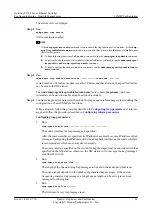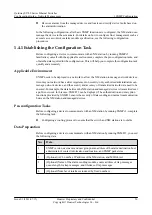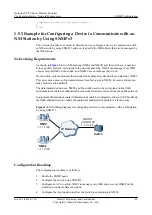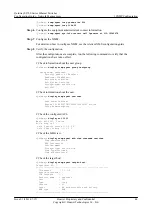
1.4.5 (Optional) Configuring the Trap Function
This section describes how to specify the alarms to be sent to the NM station, which will help
you to locate important problems. After relevant parameters are set, the security of alarm sending
can be improved.
Procedure
Step 1
Run:
system-view
The system view is displayed.
Step 2
Run:
snmp-agent trap enable
Alarm sending is enabled.
NOTE
If the
snmp-agent trap enable
command is run to enable the trap functions of all modules, or the
snmp-
agent trap enable feature-name
command is run to enable three or more trap functions of a module, note
the following points:
l
To disable the trap functions of all modules, you need to run the
snmp-agent trap disable
command.
l
To restore the trap functions of all modules to the default status, you need to run the
undo snmp-agent
trap enable
or
undo snmp-agent trap disable
command.
l
To disable one trap function of a module, you need to run the
undo snmp-agent trap enable feature-
name
command.
Step 3
Run:
snmp-agent trap enable feature-name
feature-name
trap-name
trap-name
A trap function of a feature module is enabled. This means that an alarm of a specified feature
can be sent to the NM station.
The
undo snmp-agent trap enable feature-name
command can be used to disable a trap
function of a module.
Step 4
Run:
snmp-agent trap source
interface-type
interface-number
The source interface for trap messages is specified.
After the source interface is specified, its IP address becomes the source IP address of trap
messages. Configuring the IP address of the local loopback interface as the source interface is
recommended, which can ensure device security.
The source interface specified on the switch for trap messages must be consistent with that
specified on the NM station; otherwise, the NM station will not accept the trap messages sent
from the switch.
Step 5
Run:
snmp-agent trap queue-size
size
The length of the queue storing trap messages to be sent to the destination host is set.
Quidway S2700 Series Ethernet Switches
Configuration Guide - Network Management
1 SNMP Configuration
Issue 01 (2011-07-15)
Huawei Proprietary and Confidential
Copyright © Huawei Technologies Co., Ltd.
32
















































